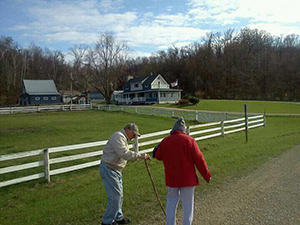UM Study Finds Longstanding Interpretation of Disability Data Incomplete (MT UCEDD/LEND)
April 7, 2017

|
University of Montana researchers with the Research and Training Center on Disability in Rural Communities, or RTC:Rural, show that the standardized disability questions used by the U.S. Department of Health and Human Services identify two distinct groups of people with disabilities: those with permanent disability and those with temporary disability. Their findings were published today in the American Journal of Public Health and can be accessed online at http://ajph.aphapublications.org/doi/abs/10.2105/AJPH.2017.303666.
The findings contradict the long-standing assumption by researchers and policymakers who use HHS disability data that it represents only people with long-term disabilities. The RTC:Rural study clarifies the survey collects information from two important subgroups: those with permanent disability, and those experiencing a temporary disability at the time of the survey.
The title of the paper is "Disability Items from the Current Population Survey (2008-2015) and Permanent Versus Temporary Disability Status." Coauthors on the study include Bryce Ward, associate director of the Bureau of Business and Economic Research at UM; RTC:Rural research associates Andrew Myers and Jennifer Wong; and Craig Ravesloot, RTC:Rural director.
"Our findings suggest that the current understanding of the entire population of people with disabilities based on HHS data is incomplete, because we have not yet accurately described the characteristics and status of these two subgroups," said Ravesloot. "This can potentially have huge implications in public health policies."
According to RTC:Rural, programs and services for people with permanent disabilities may not be effective, or appropriate, for those with a temporary disability, and vice versa. As such, the characteristics and needs of each subgroup should be considered during policy development and planning.
National surveys sponsored by the HHS are required by the Affordable Care Act to include standardized disability questions, which are used to describe the disability population and to guide policymaking. While these questions do provide valuable information, they do not provide a completely accurate picture of the disability population.
"Disability itself is a dynamic event, an interaction between a person and their environment, which makes it difficult to measure," Myers said.
The researchers analyzed Current Population Survey data from November 2008 to December 2015 to see how respondents' answers to disability questions changed over time. They also examined demographic differences between respondents who consistently reported disability (those with permanent disability) and those who reported inconsistently (those with temporary disability).
Although 17 percent of all respondents report disability throughout the survey period, of those reporting any disability, only 16 percent report the same disabilities consistently over time. Despite this inconsistency, respondents who report any disability are more similar to each other than to respondents who never report disability. However, the researchers found that those who consistently report disability are more likely to be over the age of 65, female, out of the labor force, less likely to have a college education and less likely to be married than those who sometimes report disability.
RTC:Rural researchers are especially interested in understanding the temporarily disabled population. Future research will examine whether these results are similar for people living in rural areas.
"Disability can affect anyone at any time," Ward said. "Experiencing disability for even a short period can negatively impact a person's life if they do not have access to adequate support."
Researchers at RTC:Rural, part of the UM's Rural Institute for Inclusive Communities, work to enhance the quality of life for people with disabilities in rural areas across the country. RTC:Rural research is funded by The National Institute on Disability, Independent Living and Rehabilitation Research, the research institute of the U.S. Department of Health and Human Services Administration on Community Living. The Rural Institute is part of the national network of University Centers for Excellence in Developmental Disabilities.
###
This release is online at: http://news.umt.edu/2017/03/032117disa.php
A PDF of the publication is available at: http://ajph.aphapublications.org/doi/pdf/10.2105/AJPH.2017.303666
KM/all
Dailies
032117disa







